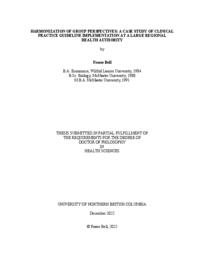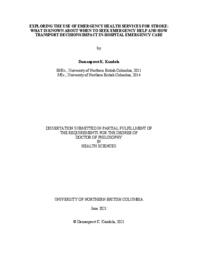Snadden, David
Person Preferred Name
David Snadden
Affiliation
Related Works
Content type
Digital Document
Description / Synopsis
Policy makers, health industry leaders, clinicians and researchers struggle to understand how new evidence-based practices, including Clinical Practice Guidelines (CPGs), can be implemented more quickly and more consistently. This retrospective qualitative case study explored sepsis CPG implementation at a British Columbia Regional Health Authority (RHA) between 2011-2017 to understand how individuals and teams with various functions and decision-making purviews come together to implement a prioritized CPG in a large RHA. The study was informed by practice theory and designed to provide practical guidance as to how CPG implementation might be better supported. Interviews involved 38 participants reflecting three functional groups: academics, regional managers and support staff, and clinicians. Over 350 documents and implementation process and outcome data were analyzed. The CPG implementation process was dynamic, involving different activities and intensities of involvement of individuals from each of the three groups. The three groups each behaved in a manner consistent with what some practice theorists call a community of practice. Individuals from each community of practice (COP) had a different perspective about the implementation along five dimensions (focus and rationale, vision, priority, appropriate balance and application of power, and goals, strategies and actions to be taken). The different COPs undertook actions that were consistent with their own COP perspective but not sufficiently aligned to ensure adherence to the CPG. The result was a discordant, and unsuccessful implementation. CPG adherence was not achieved. The differences in perspectives among the three COPs were substantial and appeared to have been deeply rooted in the beliefs, functions, experiences, and day-to-day realities of each of these groups of participants. The discordance in the implementation resulted from an insularity of each COP from the others, brought about by inadequate engagement among participants; insufficient connections across COPs to support shared understanding and alignment of action. Without some intervention, differences in perspectives will prevail and discordance is the likely outcome of any complex CPG implementation. This dissertation proposes the novel concept of harmonization as a means of achieving more successful CPG implementation; a process intended to reduce insularity of individual COPs within and beyond a RHA. Harmonization is conceptualized as a process comprised of many harmonizing activities that support engagement, relationship-building and explicit reflection and reconciliation of key differences in perspective among the three COPs. As a relational process, harmonization is largely determined by longstanding, contextual factors that support connections and collaboration among COPs. Widely engaging, horizontal, service-oriented improvement structures (with clear supporting roles and processes) establish a foundation for harmonization. Ongoing local interprofessional learning and improvement activities are essential to ensuring that the service improvement benefits from strong clinical engagement. RHA managers, particularly clinical managers, can support harmonization by encouraging open sharing of perspectives and managing in a way that is responsive to the realistic ebbs and flows of the implementation process. Harmonization integrates and builds upon many known CPG implementation determinants and strategies to bring a practical focus for future research and action.
Origin Information
Content type
Digital Document
Description / Synopsis
Transport practices for seeking emergency stroke care remain largely underresearched and poorly understood, particularly for individuals living in small urban, rural, and remote regions. This multi-method study aims to address this knowledge gap and explores the impact of mode of transport on in-hospital stroke care and the decision-making process of seeking emergency medical attention for patients and their caregivers. Data from the Discharge Abstract Database provide information on stroke-related use of emergency health services across British Columbia. Data from the Canadian Institutes for Health Information Special Project 340 provide information on if calling emergency health services impacts the delivery of care, including the completion of neuroimaging, the administration of acute thrombolysis, and the prescription of antithrombotics upon discharge across a northern health region. Focused, semi-structured interviews provide contextual insight into the decision-making processes for seeking emergency stroke care among patient and caregiver participants in a northern health region. Stroke-related emergency health service use across British Columbia from January 2015 to March 2018 was 67.9% (N=19,849), ranging from 58.8% in Northern Health to 70.2% in Fraser Health. In Northern Health (N=784), there were differences between health service delivery areas for stroke-related emergency health service use ranging from 53.7% in the Northwest to 64.8% in the Northern Interior from January 2015 to March 2018. Similar differences in thrombolytic therapy administration and the prescription of antithrombotics were noted. The odds of emergency health service use were greater for those 65 years of age and older than those younger than 65 and lower for those in the Northwest health service delivery area than those in the Northern Interior health service delivery area. Differences were found for the completion of neuroimaging between males and females. Interviews for patient (n=12) and caregiver (n=7) participants provide complementary contextual insights and yielded three key themes, including the decision-making process following a stroke, experiences of care, and perceived gaps and areas in need of further support. This integrated knowledge translation-informed and practice-driven research addresses health services and policy priorities. Findings are anticipated to help inform the development and refinement of emergency health services in British Columbia by highlighting differences in emergency health services use across geographies and identifying factors that inform patient decisionmaking when seeking emergency medical attention.
Origin Information
Content type
Digital Document
Description / Synopsis
Inequitable access to palliative care in Canada is a pressing issue. People with life-limiting illnesses in rural and remote northern and Indigenous geographies in British Columbia (BC) face ethically problematic barriers to receiving palliative care. Palliative approaches that are equity-oriented and community-based bring significant improvements to the healthcare system and to people's quality of life. The purpose of this qualitative study was to find ways to promote health equity and community-based palliative care. This research is informed by action-oriented, anti-colonial, and critical Indigenous methodologies. As perspectives of frontline healthcare workers offer transformative insights, palliative care providers working in northern BC were interviewed, and, from their interviews, three main themes emerged. These were (1) Support Primary Palliative Care, (2) earlier and inclusive Integration of Palliative care, and (3) Culturally Safe Palliative Care. The implications of these findings are situated at the intersection of cultural safety, public health, and health promotion.
Origin Information
Content type
Digital Document
Origin Information




